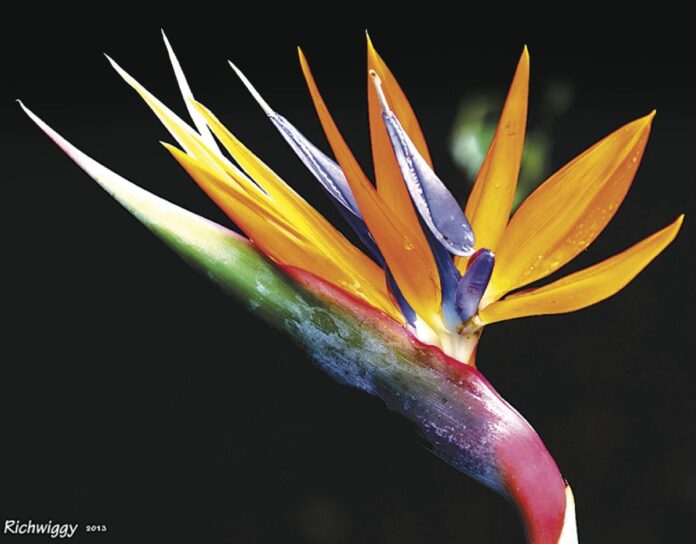BY LORI MURRAY
One of the most stunning and exotic landscape plants in USDA zones 9 through 12 is the crane flower, better known to us as Bird of Paradise. A native of South Africa and a
relative of the banana plant, the flowers have a “tongue,” usually of blue with a boat shaped base and a crown of fanned petals that mimic the plumage of the crane.
Strelitzia Nicolai and S. reginea are the most common in warm season landscapes like ours. S. Nicolai is the giant bird of paradise while S. reginea is the standard sized plant with sword-like leaves and smaller flowers. These plants have very little cold tolerance and are most commonly grown in pots, but can be a stunning addition to landscapes if they are placed where they can be protected. The plant will tolerate temperatures as low as 24 degrees for a short time, but freezing temperatures will damage developing buds and flowers. The leathery leaves are about 6 inches wide and 18 inches long, and the plant will form a clump 3 to 5 feet tall. Healthy, mature plants can produce as many as three dozen showy blooms a year that will last up to two weeks as cut flowers. (see FlowerSchool.com for a video on how to manipulate the blooms for arrangements.) Because the leaves are evergreen and do not drop from the plant, it is an excellent choice for around pools or wherever leaves are a maintenance problem. Bird of paradise grow well in warm, humid regions like ours. They require moist soil throughout their growing season and often need extra water during dry seasons, while preferring to dry out a little between watering during the fall and winter. In partial sun you will get a tall plant with large flowers; in full sun the flowers are slightly smaller and the plant slightly shorter. One source stated that bird of paradise needs at least 5 hours of sun to “flourish” and that it “survives” in partial shade. It will even tolerate light salt spray and the wind from the surf, but should not be used in exposed locations near the ocean. It does best in fertile, organic soils with good drainage. It tends to produce more flowers around the outside of the plant. Prune by cutting dead flowers and leaves down to the base. Since the plant prefers to be pot bound, check for new growth at the base to see if it is growing well. Young bird of paradise often take two to three years to bloom, so do not be discouraged if all else is well. For best growth and flowering, fertilizing is essential. Use either organic fertilizer, granular landscape fertilizer, or controlled release materials such as Osmocote. Fertilize every three months during the growing season, according to label directions. Remove any dead leaves or old flower stalks to avoid fungus.




